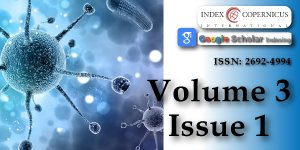A model of the 2014 Ebola virus: Evidence of West Africa
Main Article Content
Abstract
Outbreaks of Ebola virus can cause substantial mortality in affected countries. The largest outbreak of Ebola to date is currently underway in West Africa, with 3944 cases reported as of September 5, 2014. For the sake of deriving a better understanding of the Ebola transmission dynamics, we have undertaken to revisit data from the initial spark of origin of the Ebola virus, which occurred in 1976 in Zaire (now Democratic Republic of Congo). By fitting a mathematical process to time series stratified by disease onset, outcome and source of infection, we have managed to estimate several epidemiological quantities, previously admitted to be too challenging to measure, including hospital and infected community contribution infection to the widespread transmission.
Article Details
Copyright (c) 2019 Selmi N.

This work is licensed under a Creative Commons Attribution 4.0 International License.
Diekmann O, Heesterbeek J. Mathematical Epidemiology of Infectious Diseases: Model-building, Analysis, and Interpretation. West Sussex: Wiley; 2000. Ref.: https://tinyurl.com/y59kcjsk
Anderson RM, RM M. Infectious diseases of humans: Dynamics and Control. Oxford: Oxford University Press; 1991. Ref.: https://tinyurl.com/yyowvjv7
Chowell G, Fenimore PW, Castillo-Garsow MA, Castillo-Chavez C. SARS outbreaks in Ontario, Hong Kong and Singapore: the role of diagnosis and isolation as a control mechanism. J Theor Biol. 2003; 224: 1-8. Ref.: https://tinyurl.com/y25dusmd
Chowell G, Ammon CE, Hengartner NW, Hyman JM. Estimation of the reproductive number of the Spanish flu epidemic in Geneva, Switzerland. Vaccine. 2006; 24: 6747-6750. Ref.: https://tinyurl.com/y2bttwzo
Hancock K, Veguilla V, Lu X, Zhong W, Butler EN, Sun H, et al. Cross-reactive antibody responses to the 2009 pandemic H1N1 influenza virus. N Engl J Med. 2009; 361: 1945-1952. Ref.: https://tinyurl.com/yysh3t8r
Gustafsson L, Sternad M. Bringing consistency to simulation of population models--Poisson simulation as a bridge between micro and macro simulation. Math Biosci. 2007; 209: 361-385. Ref.: https://tinyurl.com/y5e87pmw
Chowell G, Ammon CE, Hengartner NW, Hyman JM. Estimating the reproduction number from the initial phase of the Spanish flu pandemic waves in Geneva, Switzerland. Math Biosci Eng. 2007a; 4: 457-470. Ref.: https://tinyurl.com/y6x6bold
Chowell G, Nishiura H, Bettencourt LM. Comparative estimation of the reproduction number for pandemic influenza from daily case notification data. J R Soc Interface. 2007b; 4: 155-166. Ref.: https://tinyurl.com/y4zeo8xd
Longini IM, Jr., Halloran ME, Nizam A, Yang Y. Containing pandemic influenza with antiviral agents. Am J Epidemiol. 2004; 159: 623-633. Ref.: https://tinyurl.com/y2nd3pjs
Chowell G, Miller MA, Viboud C. Seasonal influenza in the United States, France, and Australia: transmission and prospects for control. Epidemiol Infect. 2008; 136: 852-864. Ref.: https://tinyurl.com/yyc2m2zo
Fraser C, Donnelly CA, Cauchemez S, Hanage WP, Van Kerkhove MD, Hollingsworth TD, et al. Pandemic potential of a strain of influenza A (H1N1): early findings. Science. 2009; 324: 1557-1561. Ref.: https://tinyurl.com/y2ypzwmd
Cauchemez S, Donnelly CA, Reed C, Ghani AC, Fraser C, Kent CK, et al. Household transmission of 2009 pandemic influenza A (H1N1) virus in the United States. N Engl J Med. 2009; 361: 2619-2627. Ref.: https://tinyurl.com/y4vhlpon

